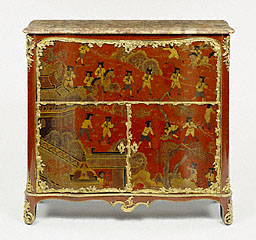• What do you think is the function of this object? Look closely at the details. How do you think it would be used? (It is a secrétaire, a cabinet that opens to form a desk when the top front section is folded down. Notice the keyholes in the lower doors.)
• Look at the decoration across the front of this secrétaire. How would you describe
it?
• In what country do you think this piece of furniture was made? (The front of this secrétaire is veneered with panels from a red lacquer chest that was imported from China. The rest of the piece was made in France.)
• What parts of this secrétaire look Chinese and what parts of it look French?
• Compare the detail on the sides with the image on the front. In what way are the sides different from the front? (The sides are made of a European imitation lacquer called vernis Martin, and show Chinese architectural scenes with no figures.)
• Look closely at the detail of the front of this secrétaire. How would you describe the figures you see there? (The scene depicts European hunters, probably members of the Dutch East India Company, who were among the first Westerners ever seen in China.)
• What reasons can you think of that Chinese artisans would be interested in showing European hunters on this lacquer panel? (This particular panel was made by the Chinese specifically to be exported to Europe. Both the Chinese and Japanese made lacquer and porcelains with designs and scenes that they thought would appeal to the European market.)
Zoom in and see the detail on the front panel on this secrétaire. |
When opened, the fall front of this secrétaire forms a writing surface, revealing red lacquered drawers and pigeonholes. Figures of European huntsmen, probably members of the Dutch East India Company, adorn the single large panel used to decorate the secrétaire's front. The Dutch maintained almost sole control of trade with China in the 1700s; the Chinese called them the "Southern Barbarians" and often depicted them on lacquerwork and porcelain.
The size of the large Chinese lacquer panel probably determined this secrétaire's unusually low and wide shape. French craftsmen cut up the piece of lacquer, attached it to the carcass, and then painted vernis Martin on the other sides and the frame. Scholars named this technique after the Martin brothers, who were granted a monopoly for making imitations of Chinese and Japanese lacquer in 1730; now the term refers to all French lacquer of this type. French furniture decorated with Chinese lacquer is rare, as French craftsmen usually preferred pieces from Japan.
About the Artist
Jacques Dubois, a descendant of a family of French ébénistes (a name that refers to their work with exotic woods, such as ebony), probably learned the craft in the workshop of his half-brother, Nöel Gérard, an important cabinetmaker and dealer of the 1720s and 1730s. Dubois did not become a master until relatively late in his career, at the age of 48. The inventory made after his death reveals a large workshop with a varied range of production including secrétaires, writing desks, pedestals, and clocks, decorated with floral marquetry or with Chinese or Japanese lacquer. While Dubois did not provide furniture for the French court, he did produce pieces for royalty such as Madame Elisabeth, Louis XV's daughter who married the Duke of Parma. |
